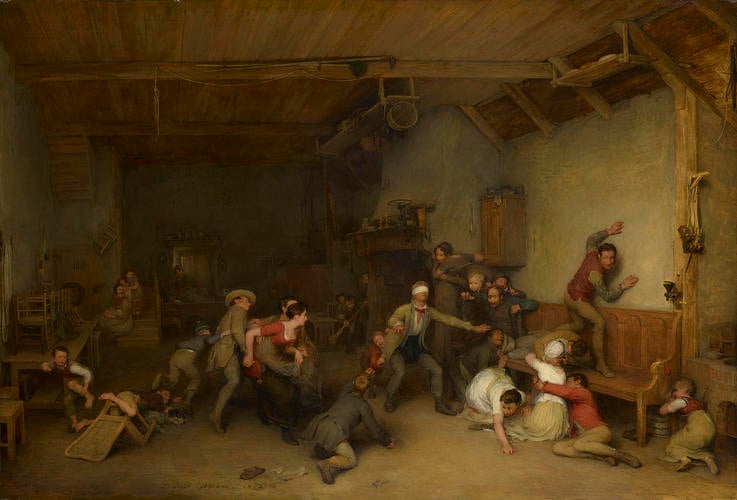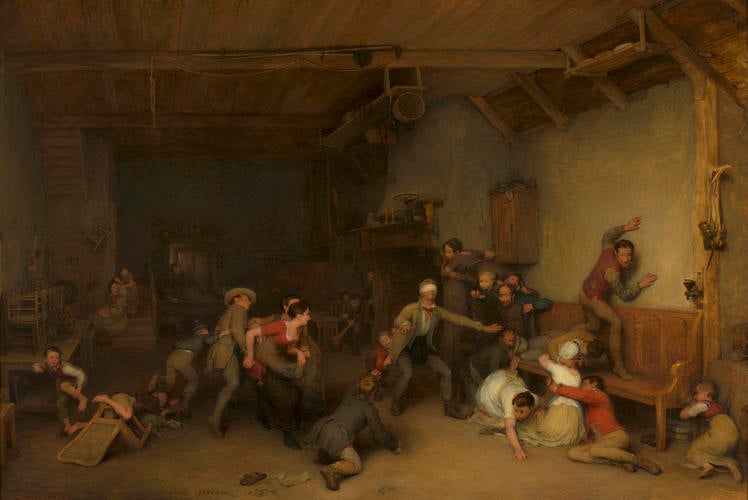Blind-Man's Buff Signed and dated 1812
Oil on panel | 63.2 x 91.8 cm (support, canvas/panel/stretcher external) | RCIN 405537
-
David Wilkie was one of the most successful painters of the Regency period and was greatly encouraged by the Regent. Born in Fife, trained in Edinburgh, Wilkie settled in London in 1805 and began regularly exhibiting at the Royal Academy small scale scenes of everyday life. At this time old master genre painting was hugely popular and expensive, as is demonstrated by the many examples of the work of Teniers and van Ostade (Adriaen and Isaac) collected at this time by George IV. Wilkie consciously emulated these low-life scenes, charging similarly high prices, but the meaning of his work shifts with the tide of British culture in the later eighteenth century towards a more celebratory (some would say sentimental) treatment of ordinary people. Teniers painted ‘peasants’; Wilkie painted the ‘the salt of the earth’. Wilkie’s royal career involved succeeding Raeburn as Limner to the King in Scotland in 1823 and Lawrence as Principal Painter in Ordinary to the King in 1830; he remained in these positions until his death, although Queen Victoria disliked his work.
The oil sketch for this picture (Tate) is dated 1811 and many drawings exist for the composition and individual elements. Wilkie dated the final painting 1812, but was still working on it in 1813, redoing figures, according to Farington, with ‘models to sit for him’, his usual practice from which he had departed. Wilkie was paid 500 guineas for the finished work which hung in the Upper Anti Room at Carlton House with works by Adriaen and Isaac Ostade, Jan Steen and others. In 1823 it was sent to the King's Lodge (later Royal Lodge) in Windsor Park, the home of the King's sporting and rustic paintings.
The Prince Regent commissioned this work as a companion to Edward Bird’s ‘Country Choristers' (OM 685, 405540); in 1818 the Prince commissioned ‘The Penny Wedding’ (OM 1176, 405536) as a companion to this. It can therefore be paired off in two ways, both partners are cheerful depictions of honest poverty and don’t particularly clarify the meaning of this picture, which Benjamin West described as depicting ‘a youthful company playing at Blindmans Buff’, adding that ‘life with mirth and good temper is seen in every group and in every figure’. The nearest source from the old masters would be the crowded multi-episode interiors of Jan Steen, like his ‘Merrymaking in a Tavern’ (CW 192, 404813) acquired by the Prince in 1814, but well known before that in the Baring Collection. Wilkie seems especially anxious to match the deep perspective of Steen’s interior (or others like it), but again his subject is mirth rather than folly. The composition seems to suggest that those chased have joined up in a sort of conga, perhaps to tease the chaser by making it too easy; this conga has pulled apart to let him through without touching anyone; in the process people tumble, some still clutching their neighbour’s waist in what is clearly becoming an amorous embrace. The suggestion would then seem to be that ‘Love is Blind’ and that we are all stumbling around trying to find a waist to clutch when the music stops.
Signed and dated: 'David Wilkie. 1812'Provenance
Painted for George IV when Prince Regent in 1812-13; recorded in the Upper Anti Room at Carlton House in 1819 (no 155); taken to Royal Lodge ('King's Lodge') at Windsor Park in 1824; recorded in the 'Wilkie Bedroom' at Buckingham Palace in 1858
-
Creator(s)
Acquirer(s)
-
Medium and techniques
Oil on panel
Measurements
63.2 x 91.8 cm (support, canvas/panel/stretcher external)
80.8 x 109.2 x 8.8 cm (frame, external)
Category
Object type(s)












